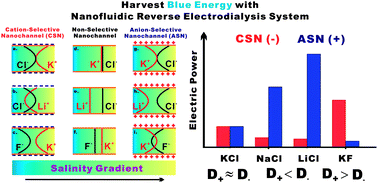Towards understanding the nanofluidic reverse electrodialysis system: well matched charge selectivity and ionic composition†
Abstract
The widespread use of tiny electrical devices, from microelectromechanical systems (MEMS) to portable personal electronics, provides a new challenge in the miniaturization and integration of power supply systems. Towards this goal, we have recently demonstrated a bio-inspired nanofluidic energy harvesting system that converts salinity gradient energy from the ambient environment into sustainable electricity with single ion-selective nanopores (Adv. Funct. Mater. 2010, 20, 1339). The nanofluidic reverse electrodialysis system (NREDS) significantly improves the performance of conventional membrane-based reverse electrodialysis systems due to a higher ionic flux and a lower fluidic resistance. However, the fundamental working mechanism of the NREDS has been largely unexplored in the literature. In this work we have systematically investigated the performance of the NREDS in relation to the electrolyte type and the charge selectivity of the nanofluidic channel using both experimental and theoretical approaches. Experimental results show that the short-circuit current, the open-circuit voltage, and the resulting electric power of the NREDS are very sensitive to the ionic composition of the electrolyte solution. Through an in-depth theoretical analysis, two dominant factors that govern the charge separation and ion selectivity of the nanochannels were identified. The results prove that, with well-matched electrolyte types and nanopore charge selectivity, the harvested electric power and energy conversion efficiency can be improved by nearly two orders of magnitude.


 Please wait while we load your content...
Please wait while we load your content...